Sesame
Sesame (/ˈsɛsəmiː/; Sesamum indicum) is a flowering plant in the genus Sesamum, also called benne.[2] Numerous wild relatives occur in Africa and a smaller number in India. It is widely naturalized in tropical regions around the world and is cultivated for its edible seeds, which grow in pods. World production in 2016 was 6.1 million tonnes, with Tanzania, Myanmar, India, and Sudan as the largest producers.[3]
| Sesame | |
|---|---|
 | |
 | |
| Sesame plants | |
| Scientific classification | |
| Kingdom: | Plantae |
| Clade: | Tracheophytes |
| Clade: | Angiosperms |
| Clade: | Eudicots |
| Clade: | Asterids |
| Order: | Lamiales |
| Family: | Pedaliaceae |
| Genus: | Sesamum |
| Species: | S. indicum |
| Binomial name | |
| Sesamum indicum | |
| Synonyms[1] | |
| |
Sesame seed is one of the oldest oilseed crops known, domesticated well over 3000 years ago. Sesamum has many other species, most being wild and native to sub-Saharan Africa. S. indicum, the cultivated type, originated in India[4] and is tolerant to drought-like conditions, growing where other crops fail.[5][6] Sesame has one of the highest oil contents of any seed. With a rich, nutty flavor, it is a common ingredient in cuisines across the world.[7][8] Like other seeds and foods, it can trigger allergic reactions in some people.
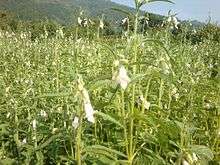
Etymology
The word "sesame" is from Latin sesamum and Greek sēsamon; which in turn are derived from ancient Semitic languages, e.g., Akkadian šamaššamu.[9] From these roots, words with the generalized meaning "oil, liquid fat" were derived.[10][11]
Origins and history
Sesame seed is considered to be the oldest oilseed crop known to humanity.[5] The genus has many species, and most are wild. Most wild species of the genus Sesamum are native to sub-Saharan Africa. S. indicum, the cultivated type,[4][12] originated in India.[13][14]
Archaeological remnants suggest sesame was first domesticated in the Indian subcontinent dating to 5500 years ago.[15][16] Charred remains of sesame recovered from archeological excavations have been dated to 3500-3050 BC.[17] Fuller claims trading of sesame between Mesopotamia and the Indian subcontinent occurred by 2000 BC.[18] It is possible that the Indus Valley Civilization exported sesame oil to Mesopotamia, where it was known as ilu in Sumerian and ellu in Akkadian. One theory is that these words derive from the Tamil name for sesame (el or ellu).
Some reports claim sesame was cultivated in Egypt during the Ptolemaic period,[19] while others suggest the New Kingdom.[20][21][22] Egyptians called it sesemt, and it is included in the list of medicinal drugs in the scrolls of the Ebers Papyrus dated to be over 3600 years old. Archeological reports from Turkey indicate that sesame was grown and pressed to extract oil at least 2750 years ago in the empire of Urartu.[8][15][23]
The historic origin of sesame was favored by its ability to grow in areas that do not support the growth of other crops. It is also a robust crop that needs little farming support—it grows in drought conditions, in high heat, with residual moisture in soil after monsoons are gone or even when rains fail or when rains are excessive. It was a crop that could be grown by subsistence farmers at the edge of deserts, where no other crops grow. Sesame has been called a survivor crop.[6]
Botany
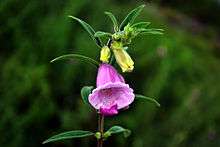
Sesame is an annual plant growing 50 to 100 cm (1.6 to 3.3 ft) tall, with opposite leaves 4 to 14 cm (1.6 to 5.5 in) long with an entire margin; they are broad lanceolate, to 5 cm (2 in) broad, at the base of the plant, narrowing to just 1 cm (0.4 in) broad on the flowering stem. The flowers are white, tubular, 3 to 5 cm (1.2 to 2.0 in) long, with a four-lobed mouth. The flowers may vary in colour, with some being white, blue, or purple. Sesame seeds occur in many colours depending on the cultivar. The most traded variety of sesame is off-white coloured. Other common colours are buff, tan, gold, brown, reddish, gray, and black. The colour is the same for the hull and the fruit.

Sesame fruit is a capsule, normally pubescent, rectangular in section, and typically grooved with a short, triangular beak. The length of the fruit capsule varies from 2 to 8 cm, its width varies between 0.5 and 2.0 cm, and the number of loculi varies from four to 12. The fruit naturally splits open (dehisces) to release the seeds by splitting along the septa from top to bottom or by means of two apical pores, depending on the varietal cultivar. The degree of dehiscence is of importance in breeding for mechanised harvesting, as is the insertion height of the first capsule.
Sesame seeds are small. Their sizes vary with the thousands of varieties known. Typically, the seeds are about 3 to 4 mm long by 2 mm wide and 1 mm thick. The seeds are ovate, slightly flattened, and somewhat thinner at the eye of the seed (hilum) than at the opposite end. The mass of 100 seeds is 0.203 g.[24] The seed coat (testa) may be smooth or ribbed.
Cultivation

Sesame varieties have adapted to many soil types. The high-yielding crops thrive best on well-drained, fertile soils of medium texture and neutral pH. However, these have low tolerance for soils with high salt and water-logged conditions. Commercial sesame crops require 90 to 120 frost free days. Warm conditions above 23 °C (73 °F) favor growth and yields. While sesame crops can grow in poor soils, the best yields come from properly fertilized farms.[8][25]
Initiation of flowering is sensitive to photoperiod and sesame variety. The photoperiod also affects the oil content in sesame seed; increased photoperiod increases oil content. The oil content of the seed is inversely proportional to its protein content.
Sesame is drought-tolerant, in part due to its extensive root system. However, it requires adequate moisture for germination and early growth. While the crop survives drought and presence of excess water, the yields are significantly lower in either condition. Moisture levels before planting and flowering impact yield most.
Most commercial cultivars of sesame are intolerant of water-logging. Rainfall late in the season prolongs growth and increases loss to dehiscence, when the seedpod shatters, scattering the seed. Wind can also cause shattering at harvest.
Processing
Sesame seeds are protected by a capsule that bursts when the seeds are ripe. The time of this bursting, or "dehiscence", tends to vary, so farmers cut plants by hand and place them together in an upright position to continue ripening until all the capsules have opened. The discovery of an indehiscent mutant (analogous to nonshattering domestic grains) by Langham in 1943 began the work towards development of a high-yielding, dehiscence-resistant variety. Although researchers have made significant progress in sesame breeding, harvest losses due to early dehiscence continue to limit domestic US production.[26]
Since sesame is a small, flat seed, it is difficult to dry it after harvest because the small seed makes movement of air around the seed difficult. Therefore, the seeds need to be harvested as dry as possible and stored at 6% moisture or less. If the seed is too moist, it can quickly heat up and become rancid.[7]
After harvesting, the seeds are usually cleaned and hulled. In some countries, once the seeds have been hulled, they are passed through an electronic colour-sorting machine that rejects any discolored seeds to ensure perfect colour, because sesame seeds with consistent appearance are perceived to be of better quality by consumers, and sell for a higher price.
Immature or off-sized seeds are removed and used for sesame oil production.
Production and trade
| Sesame seed production – 2016 | |
|---|---|
| Country | Production (tonnes) |
In 2016, world production of sesame seeds was 6.1 million tonnes, led by Tanzania, Myanmar, India, and Sudan (table).[3]
The white and other lighter-coloured sesame seeds are common in Europe, the Americas, West Asia, and the Indian subcontinent. The black and darker-coloured sesame seeds are mostly produced in China and Southeast Asia.[27]
Trade
Japan is the world's largest sesame importer. Sesame oil, particularly from roasted seed, is an important component of Japanese cooking and traditionally the principal use of the seed. China is the second-largest importer of sesame, mostly oil-grade. China exports lower-priced food-grade sesame seeds, particularly to Southeast Asia. Other major importers are the United States, Canada, the Netherlands, Turkey, and France.
Sesame seed is a high-value cash crop. Prices have ranged between US$800 and 1700 per metric ton between 2008 and 2010.[28][29]
Sesame exports sell across a wide price range. Quality perception, particularly how the seed looks, is a major pricing factor. Most importers who supply ingredient distributors and oil processors only want to purchase scientifically treated, properly cleaned, washed, dried, colour-sorted, size-graded, and impurity-free seeds with a guaranteed minimum oil content (not less than 40%) packed according to international standards. Seeds that do not meet these quality standards are considered unfit for export and are consumed locally. In 2008, by volume, premium prices, and quality, the largest exporter was India, followed by Ethiopia and Myanmar.[7][30]
Nutritional information
| Nutritional value per 100 grams | |
|---|---|
| Energy | 573 kcal (2,400 kJ) |
23.4 | |
| Sugars | 0.3 |
| Dietary fiber | 11.8 |
49.7 | |
| Saturated | 7.0 |
| Monounsaturated | 18.8 |
| Polyunsaturated | 21.8 |
17.7 | |
| Vitamins | Quantity %DV† |
| Vitamin A | 9 IU |
| Thiamine (B1) | 69% 0.79 mg |
| Riboflavin (B2) | 21% 0.25 mg |
| Niacin (B3) | 30% 4.52 mg |
| Vitamin B6 | 61% 0.79 mg |
| Folate (B9) | 24% 97 μg |
| Vitamin C | 0% 0 mg |
| Vitamin E | 2% 0.25 mg |
| Minerals | Quantity %DV† |
| Calcium | 98% 975 mg |
| Iron | 112% 14.6 mg |
| Magnesium | 99% 351 mg |
| Phosphorus | 90% 629 mg |
| Potassium | 10% 468 mg |
| Sodium | 1% 11 mg |
| Zinc | 82% 7.8 mg |
| Other constituents | Quantity |
| Water | 4.7 g |
| |
| †Percentages are roughly approximated using US recommendations for adults. Source: USDA Nutrient Database | |
In a 100 g (3.5 oz) amount, dried whole sesame seeds provide 573 calories and are composed of 5% water, 23% carbohydrates (including 12% dietary fiber), 50% fat, and 18% protein. Whole sesame seeds are rich (20% or more of the Daily Value) in several B vitamins and dietary minerals, especially iron, magnesium, calcium, phosphorus, and zinc.
The byproduct that remains after oil extraction from sesame seeds, also called sesame oil meal, is rich in protein (35-50%) and is used as feed for poultry and livestock.[7][8][27]
Health effects
A meta-analysis showed that sesame consumption produced small reductions in both systolic and diastolic blood pressure.[31] Sesame oil studies reported a reduction of oxidative stress markers and lipid peroxidation.[32]
Chemical composition
Sesame seeds contain the lignans sesamolin, sesamin, pinoresinol, and lariciresinol.[33][34]
Culinary
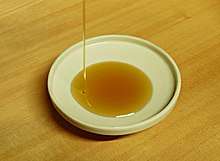
Sesame seed is a common ingredient in various cuisines. It is used whole in cooking for its rich, nutty flavour. Sesame seeds are sometimes added to breads, including bagels and the tops of hamburger buns. They may be baked into crackers, often in the form of sticks. In Sicily and France, the seeds are eaten on bread (ficelle sésame, sesame thread). In Greece, the seeds are also used in cakes.
Fast-food restaurants use buns with tops sprinkled with sesame seeds. About 75% of Mexico's sesame crop is purchased by McDonald's[35] for use in their sesame seed buns worldwide.[36]
In Asia, sesame seeds are sprinkled onto some sushi-style foods. In Japan, whole seeds are found in many salads and baked snacks, and tan and black sesame seed varieties are roasted and used to make the flavouring gomashio. East Asian cuisines, such as Chinese cuisine, use sesame seeds and oil in some dishes, such as dim sum, sesame seed balls (Cantonese: jin deui), and the Vietnamese bánh rán. Sesame flavour (through oil and roasted or raw seeds) is also very popular in Korean cuisine, used to marinate meat and vegetables. Chefs in tempura restaurants blend sesame and cottonseed oil for deep-frying.
Sesame, or simsim as it is known in East Africa, is used in African cuisine. In Togo, the seeds are a main soup ingredient and in the Democratic Republic of the Congo and in the north of Angola, wangila is a dish of ground sesame, often served with smoked fish or lobster.
Sesame seeds and oil are used extensively in India. In most parts of the country, sesame seeds mixed with heated jaggery, sugar, or palm sugar is made into balls and bars similar to peanut brittle or nut clusters and eaten as snacks. In Manipur, black sesame is used in the preparation of chikki and cold-pressed oil. In Assam, black sesame seeds are used to make til pitha and tilor laru (sesame seed balls), as well as used with meat to cook til mangko during bihu. In Punjab and Tamil Nadu, a sweet ball called pinni in Urdu and ell urundai in Tamil, ellunda in Malayalam, yellunde/chigali, (sesame ball, usually in jaggery), is made of its seeds mixed with sugar. It is eaten in various forms during the festival of Makar Sankranti.
Sesame oil is used extensively in the cuisine of Tamil Nadu. Milagai podi, a ground powder made of sesame and dry chili, is used to enhance flavor, and is consumed along with other traditional foods such as idli. In Tamil Nadu and Andhra Pradesh, sesame oil is used as a preservative and to temper the heat of their spicy foods, pickles, and condiments.
Sesame seed cookies and wafers, both sweet and savory, are popular in places such as Charleston, South Carolina. Sesame seeds, also called benne, are believed to have been brought into 17th-century colonial America by West African slaves. Since then, they have become part of various American cuisines.
In Caribbean cuisine, sugar and white sesame seeds are combined into a bar resembling peanut brittle and sold in stores and street corners.
Sesame is a popular and essential ingredient in many Middle Eastern cuisines. Sesame seeds are made into a paste called tahini (used in various ways, including hummus bi tahini) and the Middle Eastern confection halvah. Ground and processed, the seed is also used in sweet confections. Sesame is also a common component of the Levantine spice mixture za'atar, popular throughout the Middle East.[37][38]
In South Asian, Middle Eastern, and East Asian cuisines, popular confectionery are made from sesame mixed with honey or syrup and roasted into a sesame candy. In Japanese cuisine, goma-dofu is made from sesame paste and starch.
Mexican cuisine refers to sesame seeds as ajonjolí. It is mainly used as a sauce additive, such as mole or adobo. It is often also used to sprinkle over artisan breads and baked in traditional form to coat the smooth dough, especially on whole-wheat flatbreads or artisan nutrition bars, such as alegrías.
In Sicilian cuisine, what are commonly called "Italian sesame seed cookies" are known as giuggiuleni . A giuggiulena usually refers to a cookie, while a giurgiulena usually refers to a nougat-like candy, often made as a Christmas food. Both are alternative spellings for "sesame seed" in the Sicilian language.
Sesame oil is sometimes used as a cooking oil in different parts of the world, though different forms have different characteristics for high-temperature frying. The "toasted" form of the oil (as distinguished from the "cold-pressed" form) has a distinctive pleasant aroma and taste, and is used as table condiment in some regions, especially in East Asia. Toasted sesame oil is also added to flavor soups and other hot dishes, usually just before serving, to avoid dissipating the volatile scents of the food too rapidly.
Gallery
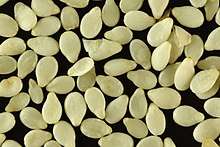 Magnified image of white sesame seeds
Magnified image of white sesame seeds- Sesame seeds are commonly added to baked goods and creative confectionery
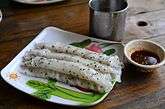 Rolled khao phan with black sesame seeds
Rolled khao phan with black sesame seeds Sesame seed breadsticks
Sesame seed breadsticks Sesame sweet cake
Sesame sweet cake.jpg) Sesame seed ball confection
Sesame seed ball confection Til-patti – a delicacy from India
Til-patti – a delicacy from India
Allergy
Sesame can trigger the same symptoms as seen with other food allergies, including anaphylaxis.[39] Sesame oil can also be a culprit because the allergy-triggering proteins may be present in the oil. Prevalence is higher in people who have allergic reactions to other foods.[39] A cross-reactivity apparently exists between sesame allergens and peanut, rye, kiwifruit, poppy seed, and various tree nuts (such as hazelnut, black walnut, cashew, macadamia, and pistachio).[40]
Amounts as low as 100 mg of sesame seeds or sesame seed flour, or 3 ml of oil can trigger allergic reactions in severe cases of sesame-allergic individuals. Most patients, however, show allergic reactions after consuming 2–10 g of sesame seeds or flour. The onset of the symptoms may occur within a few minutes up to 90 minutes after ingestion of a sesame seed product. In addition to products derived from sesame such as tahini and sesame oil, persons with sesame allergies are warned to stay away from a broad assortment of processed foods, including baked goods, tempeh, and generic "vegetable oil".[41][42] In addition to food sources, individuals allergic to sesame have been warned that a variety of non-food sources may also trigger a reaction to sesame, including adhesive bandages, cosmetics, hair-care products, perfumes, soaps and sunscreens, drugs, some fungicides and insecticides, lubricants, ointments and topical oils, and pet food.[42][43]
According to one report, "standard skin and blood testing for food allergies [does not] predict whether a child has true sesame allergy." A food challenge under the direction of a physician may be required to properly diagnose a sesame allergy.[44]
Prevalence
Prevalence of sesame allergy varies per country.[39] It is one of the three most common allergens in Israel.[45] In the United States, sesame is the ninth most common allergen,[46][47][48] with prevalence increasing.[39] Such increasing prevalence led Canada to issue regulations that require food labels to note the presence of sesame.[49] It is not required to be listed on food packaging in the United States.[46] In October 2018, U.S Food and Drug Administration requested information from researchers, medical professionals and consumers about prevalence and severity sesame allergies.[46] As of October 2019, the FDA has not released any new information on sesame allergies.[46] In October 2019, the NIH conducted a study, discovering that the sesame allergy has been found in about 17% of children with food allergies.[50] It has been reported by the CDC that as of 2019, around 300,000 people are allergic to sesame.[50] The US Food and Drug Administration has issued a request for information for the consideration of labeling for sesame to help protect people who have sesame allergies.[51]
In literature
In myths, the opening of the capsule releases the treasure of sesame seeds,[52] as applied in the story of "Ali Baba and the Forty Thieves" when the phrase "Open Sesame" magically opens a sealed cave. Upon ripening, sesame pods split, releasing a pop and possibly indicating the origin of this phrase.
Sesame seeds are used conceptually in Urdu literature, in the proverbs "til dharnay ki jagah na hona", meaning a place so crowded that no room remains for a single seed of sesame, and "in tilon mein teil nahee", referring to a person who appears to be useful, but is selfish when the time for need comes, literally meaning "no oil (is left) in this sesame."
See also
References
- "The Plant List: A Working List of All Plant Species". Retrieved 14 January 2015.
- Miriam-Webster Benne
- "Sesame seed production in 2016, Crops/World Regions/Production Quantity from pick lists". UN Food and Agriculture Organization Corporate Statistical Database (FAOSTAT). 2017. Retrieved 9 September 2018.
- T. Ogasawara, k.Chiba, m.Tada in (Y. P. S. Bajaj ed ) (1988). Medicinal and Aromatic Plants, Volume 10. Springer, 1988. ISBN 978-3-540-62727-2.CS1 maint: multiple names: authors list (link)
- Raghav Ram; David Catlin; Juan Romero & Craig Cowley (1990). "Sesame: New Approaches for Crop Improvement". Purdue University.
- D. Ray Langham. "Phenology of Sesame" (PDF). American Sesame Growers Association. Archived from the original (PDF) on 2011-06-28.
- Ray Hansen (August 2011). "Sesame profile". Agricultural Marketing Resource Center.
- E.S. Oplinger; D.H. Putnam; et al. "Sesame". Purdue University.
- Merriam-Webster Dictionary. "Definition: Teel, Sesame". Merriam-Webster.
- Bedigian, D (2010). Sesame: The genus Sesamum. CRC Press. p. 400. ISBN 978-1-4200-0520-2.
- "Sesame (Sesamum indicum L.)". Gernot Katzer's Spice Pages.
- Proceedings of the Harlan Symposium 1997- The Origins of Agriculture and Crop Domestication Archived 2012-05-27 at the Wayback Machine Retrieved 2012-06-17
- Dorothea Bedigian, ed. (2010). Sesame: The genus Sesamum. CRC Press. ISBN 978-0-8493-3538-9.
- D Zohary, M Hopf – Domestication of Plants in the Old World: The Origin and Spread of Cultivated Plants in West Asia, Europe, and the Nile Valley Oxford University Press, 2000 ISBN 0-19-850356-3 Retrieved 2012-06-17
- Sesame Coordinators. "Sesame". Sesaco.
- E.S. Oplinger; D.H. Putnam; et al. "Sesame". Purdue University.
- D Bedigian and J R Harlan – Retrieved 2012-06-17
- D Q Fuller (University college London) – – Further Evidence on the Prehistory of Sesame 2003
- I Shaw – Oxford University Press, 2003 ISBN 0-19-280458-8 Retrieved 2012-06-17
- Charles Freeman – Egypt, Greece, and Rome: Civilizations of the Ancient Mediterranean Oxford University Press, 29 Apr 2004 ISBN 0-19-926364-7 Retrieved 2012-06-17
- M Serpico & R White – (editors; P T Nicholson, I Shaw-translator) (2000-03-23). Ancient Egyptian Materials and Technology. Cambridge University Press, 23 Mar 2000. ISBN 978-0-521-45257-1.CS1 maint: multiple names: authors list (link)
- A R David – Handbook to Life in Ancient Egypt Oxford University Press, 28Oct 1999 ISBN 0-19-513215-7 Retrieved 2012-06-17
- Frederic Rosengarten (2004). The Book of Edible Nuts. Dover Publications. ISBN 978-0-486-43499-5.
- Tunde-Akintunde, T. Y.; Akintunde, B. O. (2004-05-01). "Some Physical Properties of Sesame Seed". Biosystems Engineering. 88 (1): 127–129. doi:10.1016/j.biosystemseng.2004.01.009. ISSN 1537-5110.
- TJAI (2002). "Sesame: high value oilseed" (PDF). Thomas Jefferson Agriculture Institute.
- E.S. Oplinger; D.H. Putnam; A.R. Kaminski; C.V. Hanson; E.A. Oelke; E.E. Schulte & J.D. Doll (1990). "Sesame". Alternative Field Crops Manual, University of Wisconsin and University of Minnesota.
- Heuzé V., Tran G., Bastianelli D., Lebas F., 2017. Sesame (Sesamum indicum) seeds and oil meal. Feedipedia, a programme by INRA, CIRAD, AFZ and FAO. https://www.feedipedia.org/node/26 Last updated on June 22, 2017, 16:08
- "Oil seed prices and futures". Commodity Prices. July 2010.
- Mal Bennett. "Sesame" (PDF). Ag Market Research Center.
- "Sesame Export Statistics". Food and Agriculture Organization of the United Nations. 2011.
- Khosravi-Boroujeni H, Nikbakht E, Natanelov E, Khalesi S (2017). "Can sesame consumption improve blood pressure? A systematic review and meta-analysis of controlled trials". Journal of the Science of Food and Agriculture. 97 (10): 3087–3094. doi:10.1002/jsfa.8361. PMID 28387047.
- Gouveia Lde A, Cardoso CA, de Oliveira GM, Rosa G, Moreira AS (2016). "Effects of the Intake of Sesame Seeds (Sesamum indicum L.) and Derivatives on Oxidative Stress: A Systematic Review". Journal of Medicinal Food. 19 (4): 337–345. doi:10.1089/jmf.2015.0075. PMID 27074618.
- Milder, Ivon E. J.; Arts, Ilja C. W.; Betty; Venema, Dini P.; Hollman, Peter C. H. (2005). "Lignan contents of Dutch plant foods: a database including lariciresinol, pinoresinol, secoisolariciresinol and matairesinol". British Journal of Nutrition. 93 (3): 393–402. doi:10.1079/BJN20051371. PMID 15877880.
- Kuo PC, Lin MC, Chen GF, Yiu TJ, Tzen JT (2011). "Identification of methanol-soluble compounds in sesame and evaluation of antioxidant potential of its lignans". J Agric Food Chem. 59 (7): 3214–9. doi:10.1021/jf104311g. PMID 21391595.
- Laino, Charlene (March 16, 2009). "Sesame Seed Allergy Now Among Most Common Food Allergies". WebMD Health News. Washington, DC.
- "McDonald's Now Exporting from Mexico". The Toledo Blade. Reuters. October 27, 1992.
- "Inside the Spice Cabinet: Za'atar Seasoning Blend".
- "Make Your Own Za'atar Spice Mix and Kick the Flavor up a Notch".
- Charlene Laino. "Sesame Allergies on the Rise in U.S.: Sesame Seed Allergy Now Among Most Common Food Allergies". WebMD Health News.
- "Sesame seed allergy".
- "Sesame Allergy". Archived from the original on 2009-11-15. Retrieved 2011-12-13.
- "Canadian Food Inspection Agency: Sesame Allergy". 2012-03-22.
- "The Online Allergist: Sesame Allergy".
- Permaul P, et al. (Nov 2009). "Sesame allergy: role of specific IgE and skin-prick testing in predicting food challenge results". Allergy and Asthma Proceedings. 30 (6): 643–48. doi:10.2500/aap.2009.30.3294. PMC 3131114. PMID 20031010.
- Aaronov, D.; et al. (Dec 2008). "Natural history of food allergy in infants and children in Israel". Annals of Allergy, Asthma & Immunology. 101 (6): 637–40. doi:10.1016/S1081-1206(10)60228-1. PMID 19119709.
- Nigam, Minali. “1.5 Million People in the US Might Have Sesame Allergies.” CNN, Cable News Network, 5 Aug. 2019, https://www.cnn.com/2019/08/05/health/sesame-allergy-us-study/index.html?no-st=1569530150.
- Ben-Shoshan M, Harrington DW, Soller L, et al. (June 2010). "A population-based study on peanut, tree nut, fish, shellfish, and sesame allergy prevalence in Canada". The Journal of Allergy and Clinical Immunology. 125 (6): 1327–35. doi:10.1016/j.jaci.2010.03.015. PMID 20451985.
- Sicherer, Scott H.; Muñoz-Furlong, Anne; Godbold, James H.; Sampson, Hugh A. (2010). "US prevalence of peanut and sesame allergy". Journal of Allergy and Clinical Immunology. 125 (6): 1322–1326. doi:10.1016/j.jaci.2010.03.029. PMID 20462634.
- "Regulatory Impact Analysis Statement: Project 1220 Enhanced Labelling for Food Allergen and Gluten Sources and Added Sulphites".
- Siegner, Cathy. “17% Of Kids with Food Allergies Are Also Allergic to Sesame.” Food Dive, Industry Dive, 6 Nov. 2019, www.fooddive.com/news/17-of-kids-with-food-allergies-are-also-allergic-to-sesame/566693/.
- "Statement from FDA Commissioner Scott Gottlieb, M.D., on the FDA's new consideration of labeling for sesame allergies". U.S. Food and Drug Administration. 29 October 2018. Retrieved 8 December 2019.
- Peter Griffee. "Sesamum indicum L." Food and Agriculture Organization of the United Nations.
Further reading
- Bedigian, Dorothea; Harlan, Jack R. (April–June 1986). "Evidence for Cultivation of Sesame in the Ancient World". Economic Botany. 40 (2): 137–154. JSTOR 4254846.
External links
| Wikimedia Commons has media related to Sesamum. |
